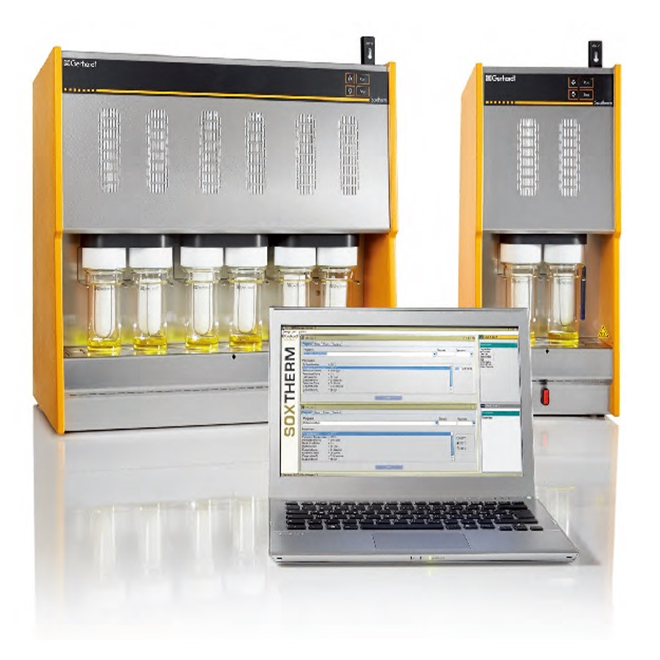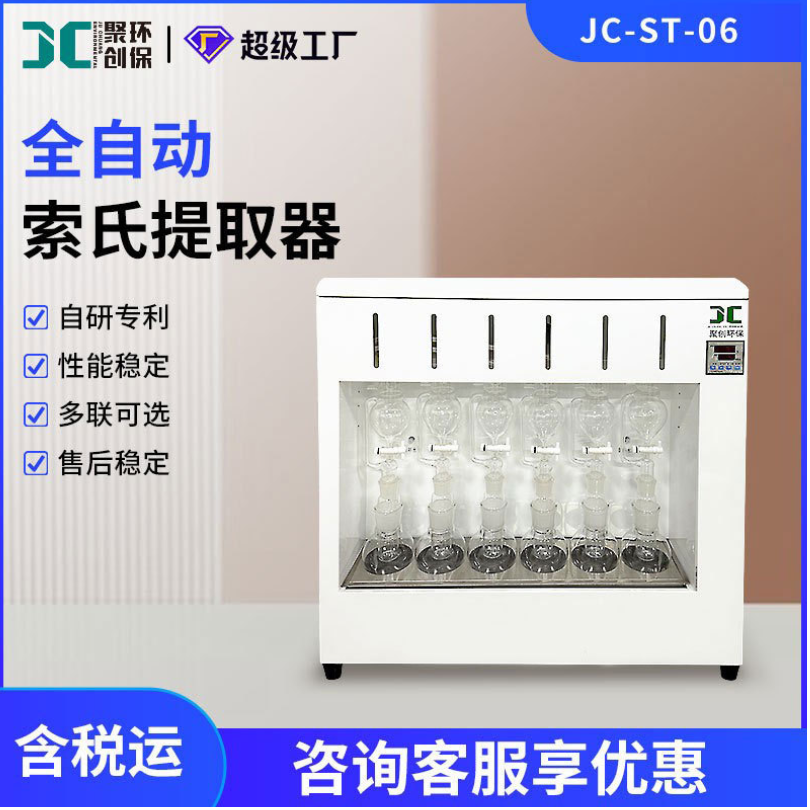四种开心果果实的脂肪酸组成Fatty Acid Composition of the Fruits of Four Varieties of Pistacia vera L
方案详情

四种开心果果实的脂肪酸组成Fatty Acid Composition of the Fruits of Four Varieties of Pistacia vera LIranian Journal of Pharmaceutical Sciences2022:17(4):87-96www.ijps.irOriginal Article Boualem S, et al. /IJPS 2021;17(4):87-96 四种开心果果实的脂肪酸组成 Fatty Acid Composition of the Fruits of Four Varieties of Pistacia vera L. Sid Ahmed Boualem., Mohamed Ghrab, Djilali Bouhadi , Abdelkader Elouissid “Department of Agronomy, Faculty of Natural and Life Sciences, University Mustapha Stambouli of Mascara,Algeria, Institute of the Olive Tree of Sfax, Tunisia, Department of Agronomy, Faculty of Natural and Life Sciences, Laboratory of Bioconversion, Microbiological Engineering and Health Safety Research, University Mustapha Stambouli of Mascara, Algeria, "Department of Agronomy, Faculty of Natural and Life Sciences, Laboratory of Biological Systems and Geomatics Research, University Mustapha Stambouli of Mascara, A lgeria. Abstract The oil content , fatty acid composit i ons of pistachio nut (Pistacia vera L.) samples corresponding to f our different varieties (Achouri, Adjmi, Batour i and Mateur ), al l cultivated in Algeria were determined. The fatty acid profiles of t he oil extracted by the Soxhle t apparatus from four main commercial pistachio varieties, were determined by gas chromatography: palmitic (C16:0), palmitoleic (C16:1), margaric (C17:0), margarolic (C17:1), stearic (C18:0), oleic (C18:1), l inoleic (C18:2), and linolenic (C18:3), oleic acid has been found as the most common monounsaturated fatty acid . Linoleic acid has the highest percentage among polyunsaturated fatty acids. There have been significant di f ferences among pistachio cultivars regarding unsaturated fatty acids. Based on the oleic to l inoleic acid (O/L) ratio, a quality i ndex was determined for t hese four varieties:Achouri (3.39)> Batouri (3.12)> Adjmi (2.89)> Mateur (2.88). Principal Component Analysis (PCA) showed the pistachio varieties div i sion into three distinct groups: Adjmi and Mateur (rich in C18.2), Batouri (rich in C16.1, C18.3 and C18.1),Achouri (rich in C16.0, C18.1). Keywords: Classi f ication, Fatty acid, Gas chromatography, Oil, Pistachio, Varieties. Corresponding author: Dr. Sid Ahmed Boualem,Department of Agronomy, University Mustapha Stambouli of Mascara, Algeria.Tel (+213) 699488044E-mail : boualem sidahmed@yahoo.com Cite this article as Boualem S, Ghrab M, Bouhadi D,Ellouissi A, Fatty Ac i d Composition of the Fruit s of Four Varieties o f Pistacia vera L., 2021, 17(4):87-96. 1. Introduction Nowadays Pistachio nut (Pistacia vera L.) is one of the most popular tree nuts in the world [1]. It is known by its high nutritional value.The pistachio kernels are a good source of fat, mainly the ones with low saturated fatty acids (SFAs) and high unsaturated fatty acids (UFAs)which plays an important role in human diet.The most advantageous fatty acids includes linolenic, linoleic and oleic acids, as they reduce the level of cholesterol in the blood and have eaalso O(cardio P protective effects [2].According to the California Pistachio Commission, the e pistachio contains 1more magnesium and copper than milk, bread and potatoes 3]. Pistachio contains 50-70% fat and larger part of that are unsaturated fatty acids. About 80% of unsaturated fatty acids are oleic and linoleic acid. Unsaturated fatty acids have several benefits on the human health such as preventing accumulation of cholesterol Iand arteriosclerosis. Essentialfatty acids are important because they are the only substance synthesizing prostaglandin 1,,Vwhich prevent erythrosine from accumulating in blood [4]. The oil extracted from the pistachio kernels is rich in oleic and linolenic acids, both playing a crucial role in therapeutic thanks to their nutritional attractive proper t ies. Expert Consultation Committee determined that replacement of carbohydrates by mono unsaturated fatty acid (MUFA) increases HDL-cholesterol [5]. Also, the increase in stabi l ity over oxidation of vegetable oil is attributed to oleic acid [6, 7]. Essential fatty acids are necessary in human diet for a good health and the reproduction. The linoleic acid, as a rich source of omega-3 group, plays an important role in the development and the maintenance of the nervous system, the physiological functions of human n organs Sand 1reduces S I LDL-total cholesterol level [8, 9]. The composition of pistachio cultivated in large plantations in Syria is known to some extent . However, no in-depth i nvestigation i nto Turkish pistachio nut oil has been carried out to date [10,11]. The aim of this study i s to identify the fatty acid composition of four varieties of pistachio nuts using Gas Chromatography (GP) method.Thiswork is part of an ongoing larger university research project on Pistachio in Algeria. The novelty of this research work is that the cultivation of pistachio has been introduced only recently in Algeria. The research field on the Pistacia vera L. species is almost not exploited. The pistachio varieties planted in the Mascara University orchard are of Syrian origin 1..This work. which consists of determining the composition of fatty acids types in these varieties, i s the first to be carried out i n Algeria. In addi t ion, the oil yield and i ts composition differs from orchard to orchard,country to country and continent to continent.Soil, topography and climatic factors are the elements that affect the growth and development of plants andt therefore the biochemical and physiological indices of plants at all levels [12]. 2. Materials and Methods 2.1. Plant Material The different samples of the pistachio varieties are: Achouri, Batouri, Adjmi and Mateur. The four samples were collected during the full maturity of the fruit at Mascara University orchard (Algeria). The samples were stored at room temperature before analysis. The plant material was obtained from a pistachio orchard (35 °22 '24.23"N,0°11 '02 12''E,Alt 475 m) identified by a confirmed taxonomist according to the herbarium code,with the specimen voucher (N°HAM01-69)registered at the Department of Agronomic Sciences Herbarium, Faculty of Nature and Life Sciences. 2.2. Oil Extraction The sample preparation process includes two steps: Oil extraction and transesterification.Oil extraction was carried out according to the method of Bligh and Dyer (1959)[13]. The Oil of 5g fruits were extracted using hexane solvent for 2husing automaticSoxhlet equipment (Gerhardt t Soxtherm) and the triplicate analysis were reported 1:for each variety. Fatty acids were t hen transformed into their methyl ester using methanolic sodium hydroxide solution in order to be analyzed by Gas Chromatography (GP). 2.3. Chromatographic Conditions A gasCchromatograph (7890N series.Agilent Technologies, Santa Clara, CA, USA)with a flame ionization detector and split/splitless injector is used to carry out t he analysis0of the fatty y acid d methyl esters (FAMEs). Separation was performed based on a DB-WAX fused silica capil l ary (100 m×0.32mm, ID 0.25 pm, BP20 0.25 UM; Perkin Elmer,Austin, TX, USA). The FID and injector temperatures were set at 220 °℃ and 280 °C, respectively. A volume of pL of FAMEs, dissolved in petroleum ether (split ratio of 1:100), was i njected directly i nto the gas chromatograph for analysis. The “hot needle injection”technique was used i n order to improve the repeatabi l ity. Oven temperature was maintained at 50 C for one minute, then increased to 200 °C at a rate of 25°C/min and then gradually increased at three C/min to reach 230°C, which was maintained for 13 min.Thus, the total time of one GC run was about 30min. The peak areas of the FAMEss were determined by the Chem Station software, and then used for multivariate data analysis. 2.4. Principal Component Analysis (PCA) Principal Component Analysis (PCA) is an extremely powerful tool to extract synthetic information from a l arge amount of quantitative data to process and i nterpret. Analysis of experimental data with a PCA method allow to reduce the dimensionality of a large number of interdependent variables into a a new set of uncorrelated variables called principal components (PC). PCA is applied to data series to construct several groups according to similar variance properties at different time scales. The first PC represents the highest variance i n the original variable, followed by the second, third and other components. This method provides useful information using a smaller set of variables and is relatively easy to i nterpret . The objectives of a PCA are as follows [14]: ·The individual's graphic representation, in a 2-dimensional plane, showing the simi l arities between them. ·The variables graphic representation, on the same level by explaining at best the initial connections between them. 3. Results and Discussion Fat content and fatty acids composition of the nuts produced in Mascara region (North West Algeria) are shown in Fig. 1, Fig2, Fig. 3,F i g. 4, F i g .5, and in Table 1. Kernel fat contents of the four studied varieties varied from 42.44% to 52.61 % based on dry ma t ter percentage,whose oi l content of the Achouri variety i s Table 1. Oil content (%) and fatty ac i d composition (%) of the four varieties of pistachio. Varieties Oil contentC16:0 C16:1 C17:0 C17:1 C18:0 C18:1 C18:2 C18:30 (Palmitic) (Palmitoleic) (Margaric) (Margarolic) (Stearic) (Oleic) (Linoleic) (Linolenic) Batouri 45.77 10.06 0.79 0.02 0.07 2.29 65.65 21.00 0.12 Achouri 52.61 11.25 0.73 0.02 0.07 1.28 66.80 19.65 0.13 Adjmi 42.44 10.11 0.74 0.02 0.06 1.29 65.12 22.51 0.14 Mateur 44.06 10.97 0.66 0.01 0.06 1.39 64.44 22.30 0.06 almost the same as that of the Momtaz variety [15]. Figures 1, 2, 3 and 4 show a typical GC chromatogram of FAMEs grown in experimenta l farm of Mascara University. Gas chromatography mas S s S spectrometry (GC-MS) was carried out to identify the fatty acid l composition of pistachio kernel oil Palmitic acid (C16:0) (10.06% to 11.25%) as saturated fatty acid, and oleic acid (C18:1)(64.44% to 66.80%) and l inoleic acid (C18:2)(19.65% to 22.51%) as unsaturated fatty acids,are the major compounds i n the chromatogram.Other types of fatty acids, i ncluding palmitoleic acid (C16:1), stearic acid (C18:0), margaric acid (C17:0), linolenic acid (C18:3) are found as minor compounds. Yi l diz et al., (1998) [16] and Okay (2002)concluded that oleic acid was the dominant fatty acid in all varieties of pistachio [17]. Table 1 shows the ranges mean values of fatty acids content for the four pistachio cultivars . The results show that the sum of oleic and linoleic acids accounts for almost 85% of the total fatty acids measured i n pistachio samples, which is also observed for other nuts,such as peanut [18]. As i t can be seen i n Table 1, in the varieties of Achouri, Adjmi, Batouri,and Mateur , the oleic acid content is Mateur
确定


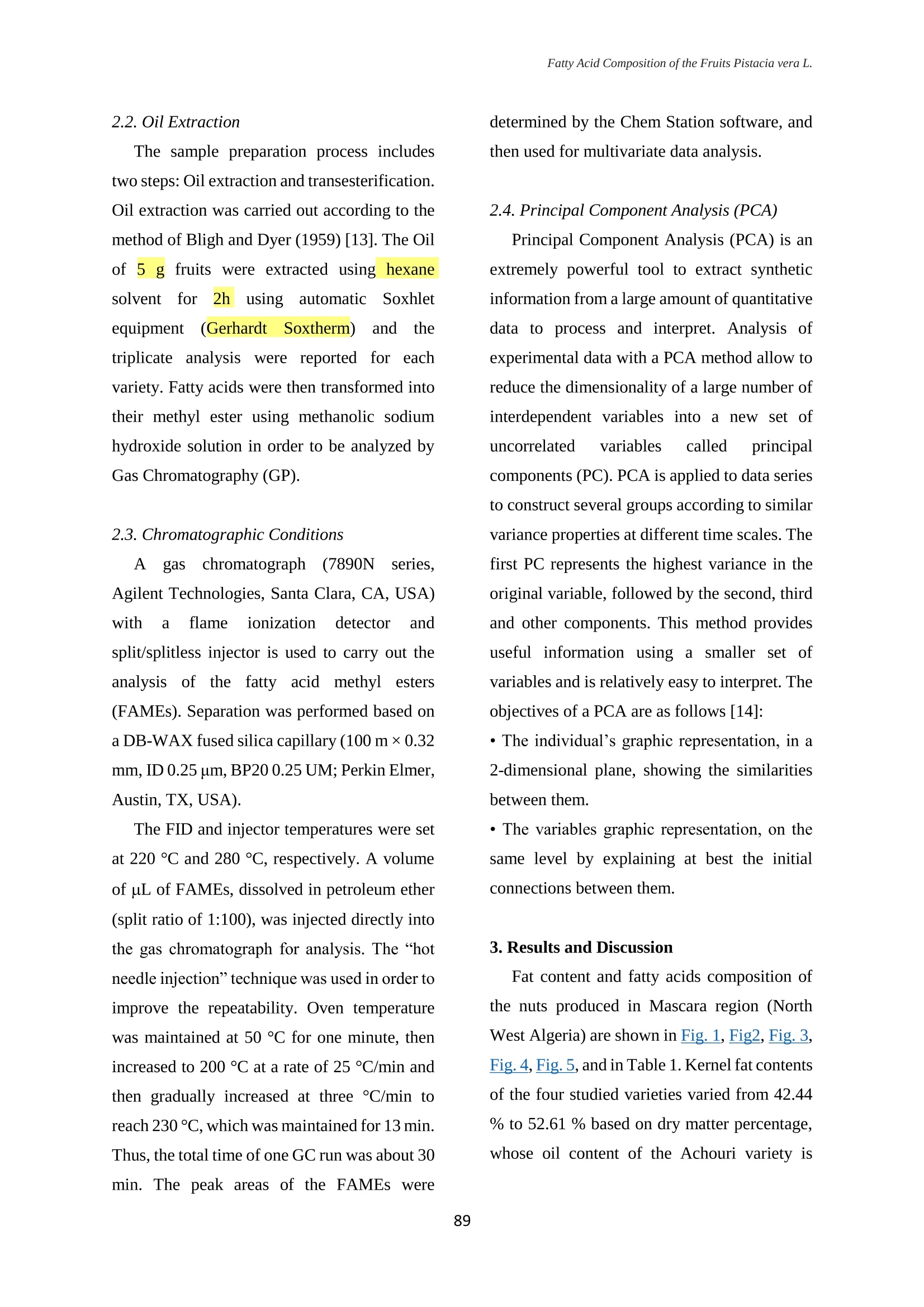

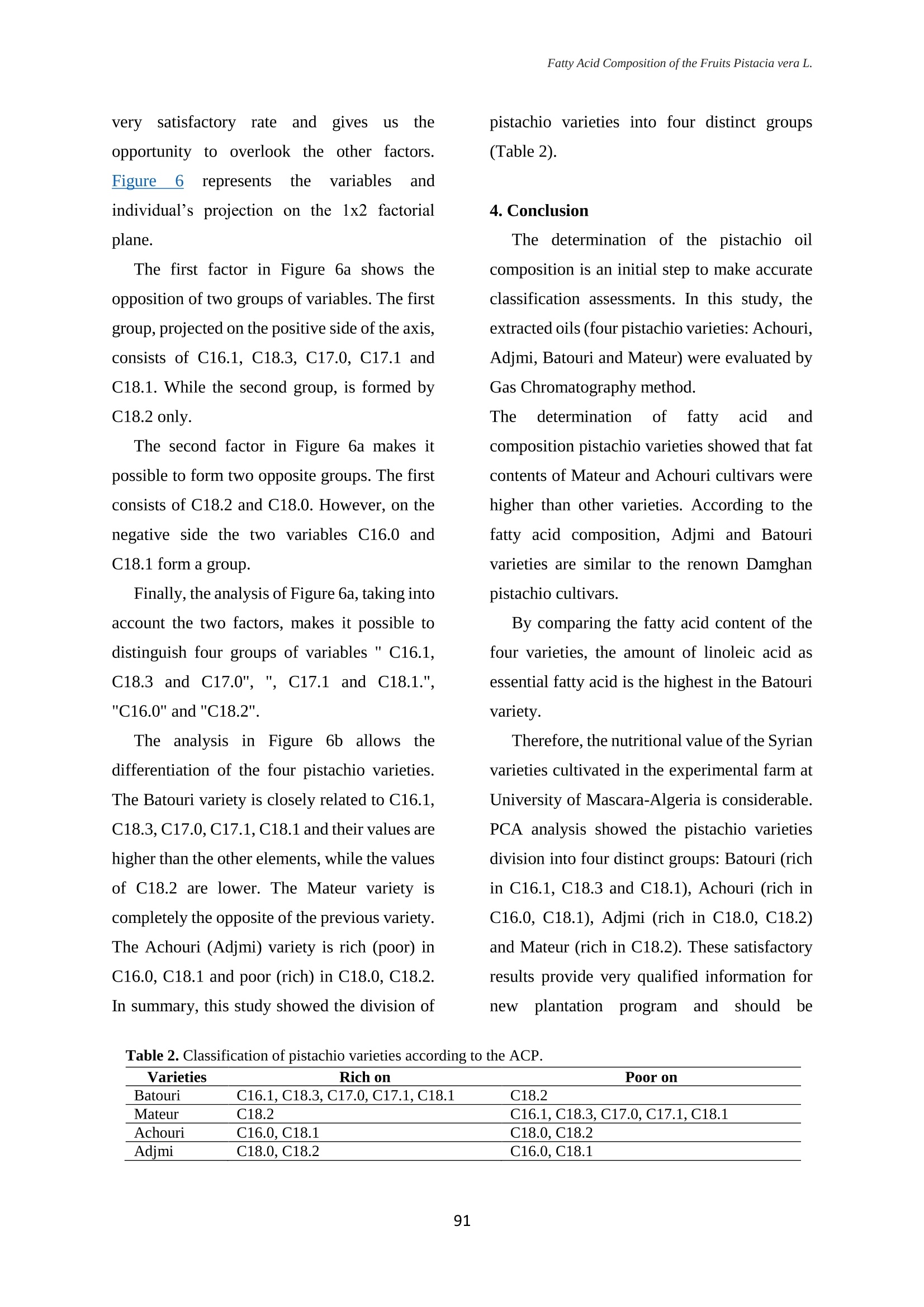
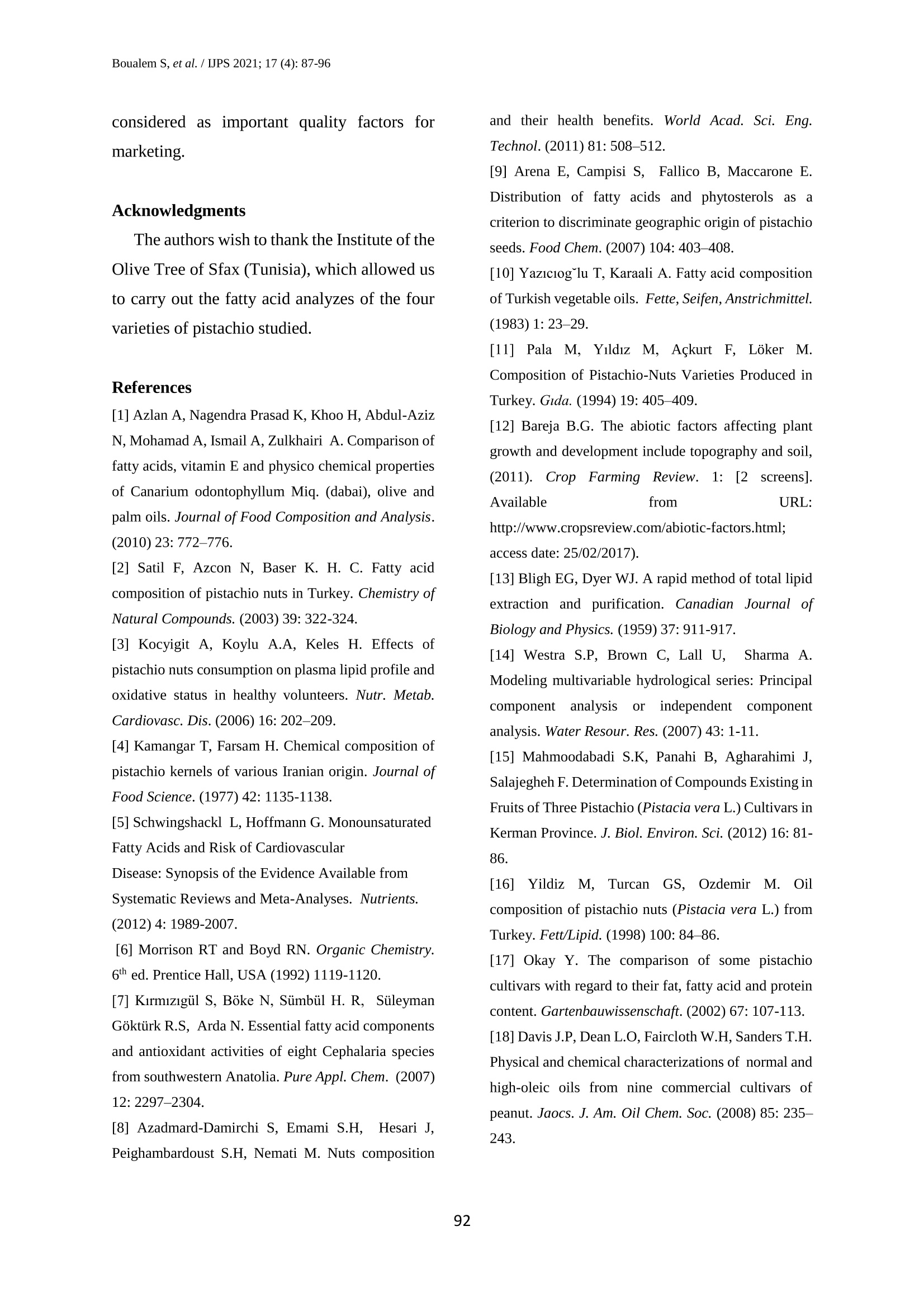


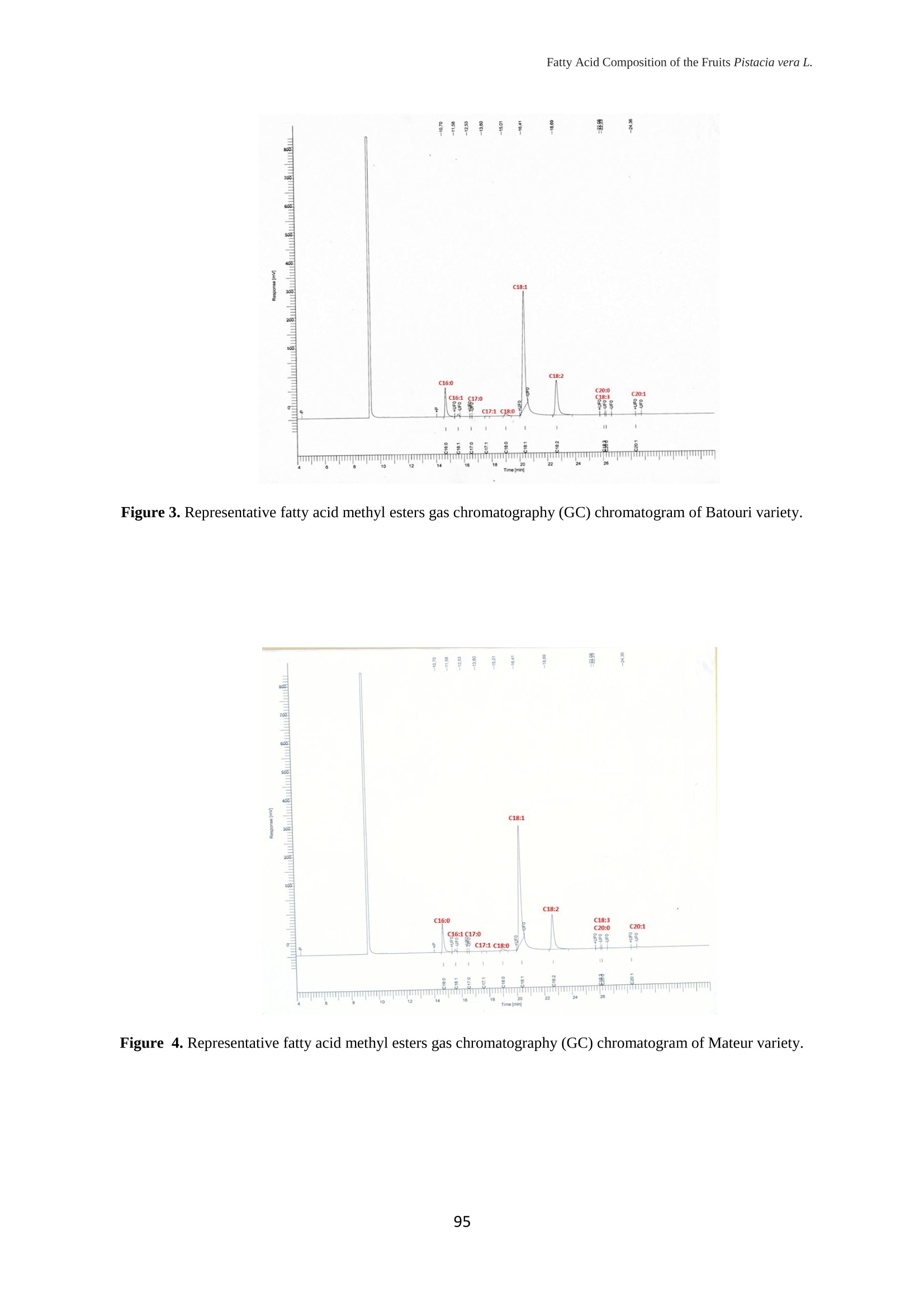

还剩8页未读,是否继续阅读?
产品配置单
中国格哈特为您提供《四种开心果果实含油率和脂肪酸组成的检测》,该方案主要用于生干坚果与籽类食品中含油率、脂肪酸检测,参考标准《GB 5009.6 食品中脂肪的测定》,《四种开心果果实含油率和脂肪酸组成的检测》用到的仪器有格哈特全自动快速索氏提取SOXTHERM、德国加液器MM、滤纸筒
推荐专场
相关方案
更多
该厂商其他方案
更多

